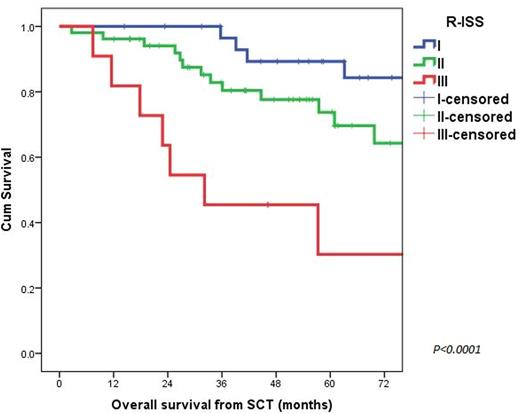Abstract

Background:
The current standard of care for eligible newly diagnosed multiple myeloma (MM) patients is induction therapy with novel agents followed by high dose chemotherapy and autologous stem cell transplant (ASCT). The International Myeloma Working Group proposed the Revised International Staging System (R-ISS) based on the presence of adverse chromosomal abnormalities (CA) detected by FISH (t(4;14), t(14;16) or del17p), in combination with ISS and LDH at diagnosis. However, there are a limited number of studies that have validated this risk model in the transplant and novel agents setting.
Aims:
To determine whether R-ISS is an appropriate risk-model for estimating overall survival (OS) and progression free survival (PFS) for transplant-eligible MM patients.
Patients and Methods:
We retrospectively studied a cohort of 519 MM patients who received novel drugs in the induction and subsequently underwent ASCT at Mayo Clinic Arizona from 2005 to 2014. In all, 95 patients met the inclusion criteria: comprising complete data at diagnosis (ISS, serum LDH level, and CA by FISH). The primary endpoint was OS from SCT and the secondary end point was PFS from ASCT. R-ISS groups were defined as described by Palumbo et al. J Clin Oncol. 2015; 33(26):2863-2869.
Results:
There were 50 (52.6%) men and 45 (47.4%) women who underwent ASCT in this period, with a median age at the time of transplant of 66-years-old (range, 36-78). There were 27 patients (28.4%) with high-risk CA: 12 patients (12.6%) with del17p; 11 patients (11.6%) with t(4;14); and 6 (6%) with t(14;16). In addition, 8 patients (8.5%) had high LDH levels and 9 patients (9.5%) presented with renal impairment at diagnosis. The patients were staged at diagnosis according to the three R-ISS groups: 44 patients (46.3%) had stage I, 26 (27.4%) had stage II, and 25 (26.3%) had stage III. CyBorD was the preferred induction regimen which was received by 42 patients (44%). There were 14 patients (15%) who received at least 2 lines of induction. All patients were in at least partial response (PR) at the moment of transplant: 32 in complete response (CR), 32 in very good partial response (VGPR) and the remaining 31 in PR. The response achieved at day +100 after ASCT improved, with 54 patients (57%) in CR, and only 18 patients (19%) in PR.
After a median follow-up of 61 months (range, 14-135), median OS from SCT was 108 months (95% CI: 85 - 132 months) and the median PFS was 45.4 months (95% CI: 31.1 - 53.8 months) in the whole series.MM patients with R-ISS III had a significantly shorter median OS compared to patients with R-ISS II or R-ISS I (32.1 months vs. 94.7 months vs. not reached, respectively, P<0.0001) (Figure). No statistically significant differences in baseline characteristics were identified among these groups to explain the differences in OS observed. PFS among these groups was not statistically significant, only showing a trend towards shorter PFS in R-ISS III compared with either R-ISS I or II: median 22.1 months vs. 35.7 months, respectively, (P=0.2).
Renal impairment at diagnosis, IgA subtype, ≥ 2 lines of induction treatment, and less than CR achieved at day +100 after ASCT were also associated with significantly inferior OS. Multivariate analysis selected R-ISS as an independent predictor for OS (HR: 2.3, 95% CI: 1.1-4.8; P=0.03), as well as ≥ 2 lines before ASCT. CR at day +100 after ASCT was the most important independent factor for predicting PFS (HR: 0.4; 95% CI: 0.2-0.6; P<0.001).
Conclusion:
R-ISS assessed at diagnosis was an independent predictor for OS after ASCT in our series, with median OS for the different R-ISS groups comparable to those reported by Palumbo et al. in their subgroup of younger patients. Thus, this study lends further support for the R-ISS as a reliable prognostic tool for estimating OS in transplant-eligible MM patients. In addition, new treatment approaches are needed for the high-risk patients (R-ISS III) with a median OS of 2.5 years.
Reeder:Millennium: Research Funding; BMS: Research Funding; Celgene: Research Funding; Novartis: Research Funding. Mikhael:Abbvie: Research Funding; Onyx: Research Funding; Sanofi: Research Funding; Celgene: Research Funding. Bergsagel:Amgen, BMS, Novartis, Incyte: Consultancy; Novartis: Research Funding. Stewart:celgene: Consultancy. Fonseca:Janssen: Consultancy; Celgene: Consultancy; Sanofi: Consultancy; Novartis: Consultancy; Bayer: Consultancy; AMGEN: Consultancy; AMGEN: Consultancy; AMGEN: Consultancy; Patent: Patents & Royalties: Prognostication of MM based on genetic categorization of FISH of the disease; AMGEN: Consultancy; Millennium, a Takeda Company: Consultancy; Janssen: Consultancy; Sanofi: Consultancy; Patent Pending: Patents & Royalties: The use of calcium isotopes as biomarkers for bone metabolisms; Novartis: Consultancy; Patent: Patents & Royalties: Prognostication of MM based on genetic categorization of FISH of the disease; Millennium, a Takeda Company: Consultancy; Millennium, a Takeda Company: Consultancy; Bayer: Consultancy; Celgene: Consultancy; Patent Pending: Patents & Royalties: The use of calcium isotopes as biomarkers for bone metabolisms; Patent: Patents & Royalties: Prognostication of MM based on genetic categorization of FISH of the disease; Patent Pending: Patents & Royalties: The use of calcium isotopes as biomarkers for bone metabolisms; BMS: Consultancy; Millennium, a Takeda Company: Consultancy; BMS: Consultancy; Patent: Patents & Royalties: Prognostication of MM based on genetic categorization of FISH of the disease; Patent Pending: Patents & Royalties: The use of calcium isotopes as biomarkers for bone metabolisms.
Author notes
Asterisk with author names denotes non-ASH members.

This icon denotes a clinically relevant abstract


This feature is available to Subscribers Only
Sign In or Create an Account Close Modal